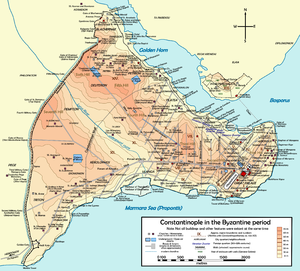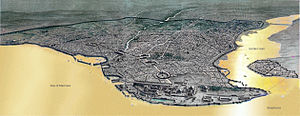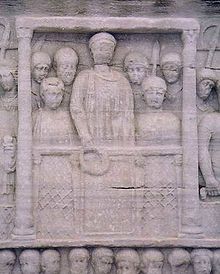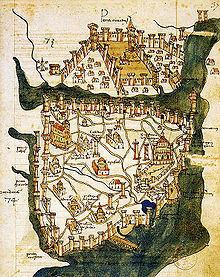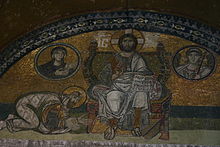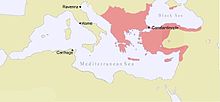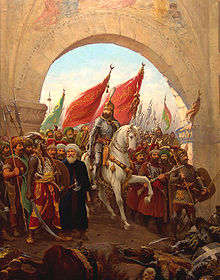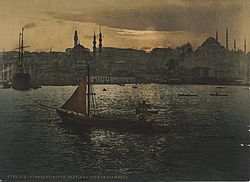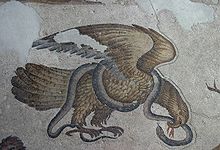
Constantinople
Background to the schools Wikipedia
This content from Wikipedia has been selected by SOS Children for suitability in schools around the world. Visit the SOS Children website at http://www.soschildren.org/
Constantinople (Greek: Κωνσταντινούπολις, Κωνσταντινούπολη – Konstantinoúpolis, Konstantinoúpoli; Latin: Constantinopolis; Ottoman Turkish: قسطنطینیه, Kostantiniyye; and modern Turkish: İstanbul) was the capital city of the Eastern Roman or Byzantine Empire, the Latin and the Ottoman Empire. It was founded in AD 330, at ancient Byzantium as the new capital of the Roman Empire by Constantine the Great, after whom it was named. In the 12th century, the city was the largest and wealthiest European city.
Eventually the empire of Christian Eastern Orthodoxy in the east was reduced to just the capital and its environs, falling to the Ottomans in the historic battle of 1453.
The city itself remained and prospered as the Muslim capital in the Ottoman period; however, scholars normally reserve the name "Constantinople" for the city in Christian period 330–1453, preferring "Istanbul" for the city's name in later centuries. However, many Western writers have continued to refer to the city by its older name "Constantinople" into modern times. The name "Constantinople" is still used by members of the Eastern Orthodox Church in the title of one of their most important leaders, the Orthodox patriarch based in the city, referred to as "His Most Divine All-Holiness the Archbishop of Constantinople New Rome and Ecumenical Patriarch."
Constantinople was famed for its massive defenses. Although besieged on numerous occasions by various peoples, it was taken only in 1204 by the army of the Fourth Crusade, in 1261 by Michael VIII Palaiologos), and – finally – in 1453 by the Ottoman Sultan Mehmed II. A first wall was erected by Constantine I, and the city was surrounded by a double wall lying about 2 km (1.2 miles) to the west of the first wall, begun during the 5th century by Theodosius II. The city was built on seven hills as well as on the Golden Horn and the Sea of Marmara, and thus presented an impregnable fortress enclosing magnificent palaces, domes and towers.
It was also famed for architectural masterpieces such as the church of Hagia Sophia, the sacred palace of the emperors, the hippodrome, and the Golden Gate, lining the arcaded avenues and squares. Constantinople contained numerous artistic and literary treasures before it was sacked in 1204 and 1453. It was virtually depopulated when it fell to the Ottoman Turks, but the city recovered rapidly, becoming once again by the mid-1600s the world's largest city as the Ottoman capital.
Names
The city was originally founded as a Greek colony under the name of Byzantium in the 7th century BC. It took on the name of Konstantinoupolis ("city of Constantine", Constantinople) after its re-foundation under Roman emperor Constantine I, who transferred the imperial capital from its historic base, Rome, to Byzantium in 330 AD and designated his new capital Nova Roma or "New Rome." The modern Turkish name for the city, İstanbul derives from the Greek phrase eis tin polin (εις την πόλιν), meaning "into the City" or "to the City". This name was used in Turkish alongside Kostantiniyye, the more formal adaptation of the original Constantinople, during the period of Ottoman rule, while western languages mostly continued to refer to the city as Constantinople until the early 20th century. After the creation of the Republic of Turkey in 1923, the Turkish government began to formally object to the use of Constantinople in other languages and ask that others use the more common name for the city.
History
Byzantium
Constantinople was founded by the Roman Emperor Constantine I (272–337 AD) on the site of an already-existing city, Byzantium, which was settled in the early days of Greek colonial expansion, probably around 671–662 BC. The site lay astride the land route from Europe to Asia and the seaway from the Black Sea to the Mediterranean, and had in the Golden Horn an excellent and spacious harbour.
306–337
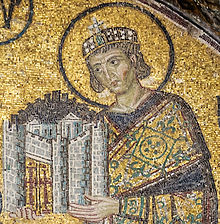
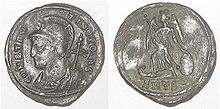
Constantine had altogether more colourful plans. Having restored the unity of the Empire, and, being in course of major governmental reforms as well as of sponsoring the consolidation of the Christian church, he was well aware that Rome was an unsatisfactory capital. Rome was too far from the frontiers, and hence from the armies and the imperial courts, and it offered an undesirable playground for disaffected politicians. Yet it had been the capital of the state for over a thousand years, and it might have seemed unthinkable to suggest that the capital be moved to a different location. Nevertheless, Constantine identified the site of Byzantium as the right place: a place where an emperor could sit, readily defended, with easy access to the Danube or the Euphrates frontiers, his court supplied from the rich gardens and sophisticated workshops of Roman Asia, his treasuries filled by the wealthiest provinces of the Empire.
Constantinople was built over 6 years, and consecrated on 11 May 330. Constantine divided the expanded city, like Rome, into 14 regions, and ornamented it with public works worthy of an imperial metropolis. Yet, at first, Constantine's new Rome did not have all the dignities of old Rome. It possessed a proconsul, rather than an urban prefect. It had no praetors, tribunes, or quaestors. Although it did have senators, they held the title clarus, not clarissimus, like those of Rome. It also lacked the panoply of other administrative offices regulating the food supply, police, statues, temples, sewers, aqueducts, or other public works. The new programme of building was carried out in great haste: columns, marbles, doors, and tiles were taken wholesale from the temples of the empire and moved to the new city. In similar fashion, many of the greatest works of Greek and Roman art were soon to be seen in its squares and streets. The emperor stimulated private building by promising householders gifts of land from the imperial estates in Asiana and Pontica and on 18 May 332 he announced that, as in Rome, free distributions of food would be made to the citizens. At the time, the amount is said to have been 80,000 rations a day, doled out from 117 distribution points around the city.
Constantine laid out a new square at the centre of old Byzantium, naming it the Augustaeum. The new senate-house (or Curia) was housed in a basilica on the east side. On the south side of the great square was erected the Great Palace of the Emperor with its imposing entrance, the Chalke, and its ceremonial suite known as the Palace of Daphne. Nearby was the vast Hippodrome for chariot-races, seating over 80,000 spectators, and the famed Baths of Zeuxippus. At the western entrance to the Augustaeum was the Milion, a vaulted monument from which distances were measured across the Eastern Roman Empire.
From the Augustaeum led a great street, the Mese (Greek: Μέση [Οδός] lit. "Middle [Street]"), lined with colonnades. As it descended the First Hill of the city and climbed the Second Hill, it passed on the left the Praetorium or law-court. Then it passed through the oval Forum of Constantine where there was a second Senate-house and a high column with a statue of Constantine himself in the guise of Helios, crowned with a halo of seven rays and looking toward the rising sun. From there the Mese passed on and through the Forum Tauri and then the Forum Bovis, and finally up the Seventh Hill (or Xerolophus) and through to the Golden Gate in the Constantinian Wall. After the construction of the Theodosian Walls in the early 5th century, it was extended to the new Golden Gate, reaching a total length of seven Roman miles.
337–527
The first known Prefect of the City of Constantinople was Honoratus, who took office on 11 December 359 and held it until 361. The emperor Valens built the Palace of Hebdomon on the shore of the Propontis near the Golden Gate, probably for use when reviewing troops. All the emperors up to Zeno and Basiliscus were crowned and acclaimed at the Hebdomon. Theodosius I founded the Church of John the Baptist to house the skull of the saint (today preserved at the Topkapı Palace in Istanbul, Turkey), put up a memorial pillar to himself in the Forum of Taurus, and turned the ruined temple of Aphrodite into a coach house for the Praetorian Prefect; Arcadius built a new forum named after himself on the Mese, near the walls of Constantine.
The importance of Constantinople gradually increased. After the shock of the Battle of Adrianople in 378, in which the emperor Valens with the flower of the Roman armies was destroyed by the Visigoths within a few days' march, the city looked to its defences, and in 413–414, Theodosius II built the 18-meter (60-foot)-tall triple-wall fortifications, which were never to be breached until the coming of gunpowder. Theodosius also founded a University near the Forum of Taurus, on 27 February 425.
Uldin, a prince of the Huns, appeared on the Danube about this time and advanced into Thrace, but he was deserted by many of his followers, who joined with the Romans in driving their king back north of the river. Subsequent to this, new walls were built to defend the city, and the fleet on the Danube improved.
In due course, the barbarians overran the Western Roman Empire: Its emperors retreated to Ravenna, and it diminished to nothing. Thereafter, Constantinople became in truth the largest city of the Roman Empire and of the world. Emperors were no longer peripatetic between various court capitals and palaces. They remained in their palace in the Great City, and sent generals to command their armies. The wealth of the eastern Mediterranean and western Asia flowed into Constantinople.
527–565
The emperor Justinian I (527–565) was known for his successes in war, for his legal reforms and for his public works. It was from Constantinople that his expedition for the reconquest of the former Diocese of Africa set sail on or about 21 June 533. Before their departure, the ship of the commander Belisarius was anchored in front of the Imperial palace, and the Patriarch offered prayers for the success of the enterprise. After the victory, in 534, the Temple treasure of Jerusalem, looted by the Romans in 70 AD and taken to Carthage by the Vandals after their sack of Rome in 455, was brought to Constantinople and deposited for a time, perhaps in the Church of St. Polyeuctus, before being returned to Jerusalem in either the Church of the Resurrection or the New Church.
Chariot-racing had been important in Rome for centuries. In Constantinople, the hippodrome became over time increasingly a place of political significance. It was where (as a shadow of the popular elections of old Rome) the people by acclamation showed their approval of a new emperor, and also where they openly criticized the government, or clamoured for the removal of unpopular ministers. In the time of Justinian, public order in Constantinople became a critical political issue.
Throughout the late Roman and early Byzantine periods, Christianity was resolving fundamental questions of identity, and the dispute between the orthodox and the monophysites became the cause of serious disorder, expressed through allegiance to the horse-racing parties of the Blues and the Greens. The partisans of the Blues and the Greens were said to affect untrimmed facial hair, head hair shaved at the front and grown long at the back, and wide-sleeved tunics tight at the wrist; and to form gangs to engage in night-time muggings and street violence. At last these disorders took the form of a major rebellion of 532, known as the "Nika" riots (from the battle-cry of "Victory!" of those involved).
Fires started by the Nika rioters consumed Constantine's basilica of St Sophia, the city's principal church, which lay to the north of the Augustaeum. Justinian commissioned Anthemius of Tralles and Isidore of Miletus to replace it with a new and incomparable St Sophia. This was the great cathedral of the Orthodox Church, whose dome was said to be held aloft by God alone, and which was directly connected to the palace so that the imperial family could attend services without passing through the streets. The dedication took place on 26 December 537 in the presence of the emperor, who exclaimed, "O Solomon, I have outdone thee!" St Sophia was served by 600 people including 80 priests, and cost 20,000 pounds of gold to build.
Justinian also had Anthemius and Isidore demolish and replace the original Church of the Holy Apostles built by Constantine with a new church under the same dedication. This was designed in the form of an equal-armed cross with five domes, and ornamented with beautiful mosaics. This church was to remain the burial place of the Emperors from Constantine himself until the 11th century. When the city fell to the Turks in 1453, the church was demolished to make room for the tomb of Mehmet II the Conqueror. Justinian was also concerned with other aspects of the city's built environment, legislating against the abuse of laws prohibiting building within 100 feet (30 m) of the sea front, in order to protect the view.
During Justinian I's reign, the city's population reached about 500,000 people. However, the social fabric of Constantinople was also damaged by the onset of the Plague of Justinian between 541–542 AD. It killed perhaps 40% of the city's inhabitants.

Survival, 565–717
In the early 7th century, the Avars and later the Bulgars overwhelmed much of the Balkans, threatening Constantinople from the west. Simultaneously, the Persian Sassanids overwhelmed the Prefecture of the East and penetrated deep into Anatolia. Heraclius, son to the exarch of Africa, set sail for the city and assumed the purple. He found the military situation so dire that he is said at first to have contemplated withdrawing the imperial capital to Carthage, but relented after the people of Constantinople begged him to stay. The citizens lost their right to free grain in 618 when Heraclius realised that the city no longer could be supplied from Egypt as a result of the Persian wars: the population dropped substantially in size as a result.
While the city withstood a siege, Heraclius campaigned deep into Persian territory and briefly restored the status quo in 628, when the Persians surrendered all their conquests. However, further sieges followed in the course of attacks from the Arabs, a first from 674 to 678, and a second from 717 to 718. At this time the Theodosian Walls kept the city impregnable from the land, while a newly discovered incendiary substance known as " Greek Fire" allowed the Byzantine navy to destroy the Arab fleets and keep the city supplied. In the second siege, decisive help was rendered by the Bulgars.
717–1025

In the 730s Leo III carried out extensive repairs of the Theodosian walls, which had been damaged by frequent and violent attacks; this work was financed by a special tax on all the subjects of the Empire.
Theodora, widow of the Emperor Theophilus (died 842), acted as regent during the minority of her son Michael III, who was said to have been introduced to dissolute habits by her brother Bardas. When Michael assumed power in 856, he became known for excessive drunkenness, appeared in the hippodrome as a charioteer and burlesqued the religious processions of the clergy. He removed Theodora from the Great Palace to the Carian Palace and later to the monastery of Gastria, but, after the death of Bardas, she was released to live in the palace of St Mamas; she also had a rural residence at the Anthemian Palace, where Michael was assassinated in 867.
In 860, an attack was made on the city by a new principality set up a few years earlier at Kiev by Askold and Dir, two Varangian chiefs: Two hundred small vessels passed through the Bosporus and plundered the monasteries and other properties on the suburban Prince's Islands. Oryphas, the admiral of the Byzantine fleet, alerted the emperor Michael, who promptly put the invaders to flight; but the suddenness and savagery of the onslaught made a deep impression on the citizens.
In 980, the emperor Basil II received an unusual gift from Prince Vladimir of Kiev: 6,000 Varangian warriors, which Basil formed into a new bodyguard known as the Varangian Guard. They were known for their ferocity, honour, and loyalty. It is said that, in 1038, they were dispersed in winter quarters in the Thracesian theme when one of their number attempted to violate a countrywoman, but in the struggle she seized his sword and killed him; instead of taking revenge, however, his comrades applauded her conduct, compensated her with all his possessions, and exposed his body without burial as if he had committed suicide. However, following the death of an Emperor, they became known also for plunder in the Imperial palaces. Later in the 11th Century the Varangian Guard became dominated by Anglo-Saxons who preferred this way of life to subjugation by the new Norman kings of England.
The Book of the Eparch, which dates to the 10th century, gives a detailed picture of the city's commercial life and its organization at that time. The corporations in which the tradesmen of Constantinople were organised were supervised by the Eparch, who regulated such matters as production, prices, import, and export. Each guild had its own monopoly, and tradesmen might not belong to more than one. It is an impressive testament to the strength of tradition how little these arrangements had changed since the office, then known by the Latin version of its title, had been set up in 330 to mirror the urban prefecture of Rome.
In the 9th and 10th centuries, Constantinople had a population of between 500,000 and 800,000.
Iconoclast controversy
In the 8th and 9th centuries, the iconoclast movement caused serious political unrest throughout the Empire. The emperor Leo III issued a decree in 726 against images, and ordered the destruction of a statue of Christ over one of the doors of the Chalke, an act that was fiercely resisted by the citizens. Constantine V convoked a church council in 754, which condemned the worship of images, after which many treasures were broken, burned, or painted over with depictions of trees, birds or animals: One source refers to the church of the Holy Virgin at Blachernae as having been transformed into a "fruit store and aviary". Following the death of his son Leo IV in 780, the empress Irene restored the veneration of images through the agency of the Second Council of Nicaea in 787.
The iconoclast controversy returned in the early 9th century, only to be resolved once more in 843 during the regency of Empress Theodora, who restored the icons. These controversies contributed to the deterioration of relations between the Western and the Eastern Churches.
Prelude to the Comnenian period, 1025–1081
In the late 11th century catastrophe struck with the unexpected and calamitous defeat of the imperial armies at the Battle of Manzikert in Armenia in 1071. The Emperor Romanus Diogenes was captured. The peace terms demanded by Alp Arslan, sultan of the Seljuk Turks, were not excessive, and Romanus accepted them. On his release, however, Romanus found that enemies had placed their own candidate on the throne in his absence; he surrendered to them and suffered death by torture, and the new ruler, Michael VII Ducas, refused to honour the treaty. In response, the Turks began to move into Anatolia in 1073. The collapse of the old defensive system meant that they met no opposition, and the empire's resources were distracted and squandered in a series of civil wars. Thousands of Turkoman tribesmen crossed the unguarded frontier and moved into Anatolia. By 1080, a huge area had been lost to the Empire, and the Turks were within striking distance of Constantinople.
1081–1185
Under the Comnenian dynasty (1081–1185), Byzantium staged a remarkable recovery. In 1090–91, the nomadic Pechenegs reached the walls of Constantinople, where Emperor Alexius I with the aid of the Kipchaks annihilated their army. In response to a call for aid from Alexius, the First Crusade assembled at Constantinople in 1096, but declining to put itself under Byzantine command set out for Jerusalem on its own account. John II built the monastery of the Pantocrator (Almighty) with a hospital for the poor of 50 beds.
With the restoration of firm central government, the empire became fabulously wealthy. The population was rising (estimates for Constantinople in the 12th century vary from some 100,000 to 500,000), and towns and cities across the realm flourished. Meanwhile, the volume of money in circulation dramatically increased. This was reflected in Constantinople by the construction of the Blachernae palace, the creation of brilliant new works of art, and general prosperity at this time: an increase in trade, made possible by the growth of the Italian city-states, may have helped the growth of the economy. It is certain that the Venetians and others were active traders in Constantinople, making a living out of shipping goods between the Crusader Kingdoms of Outremer and the West, while also trading extensively with Byzantium and Egypt. The Venetians had factories on the north side of the Golden Horn, and large numbers of westerners were present in the city throughout the 12th century. Toward the end of Manuel I's reign, the number of foreigners in the city reached about 60,000–80,000 people out of a total population of about 400,000 people. In 1171, Constantinople also contained a small community of 2,500 Jews.
In artistic terms, the 12th century was a very productive period. There was a revival in the mosaic art, for example: Mosaics became more realistic and vivid, with an increased emphasis on depicting three-dimensional forms. There was an increased demand for art, with more people having access to the necessary wealth to commission and pay for such work. According to N.H. Baynes (Byzantium, An Introduction to East Roman Civilization):
- "With its love of luxury and passion for colour, the art of this age delighted in the production of masterpieces that spread the fame of Byzantium throughout the whole of the Christian world. Beautiful silks from the work-shops of Constantinople also portrayed in dazzling colour animals – lions, elephants, eagles, and griffins – confronting each other, or represented Emperors gorgeously arrayed on horseback or engaged in the chase."
- "From the tenth to the twelfth century Byzantium was the main source of inspiration for the West. By their style, arrangement, and iconography the mosaics of St. Mark's at Venice and of the cathedral at Torcello clearly reveal their Byzantine origin. Similarly those of the Palatine Chapel, the Martorana at Palermo, and the cathedral of Cefalù, together with the vast decoration of the cathedral at Monreale, demonstrate the influence of Byzantium on the Norman Court of Sicily in the twelfth century. Hispano- Moorish art was unquestionably derived from the Byzantine. Romanesque art owes much to the East, from which it borrowed not only its decorative forms but the plan of some of its buildings, as is proved, for instance, by the domed churches of south-western France. Princes of Kiev, Venetian doges, abbots of Monte Cassino, merchants of Amalfi, and the kings of Sicily all looked to Byzantium for artists or works of art. Such was the influence of Byzantine art in the twelfth century, that Russia, Venice, southern Italy and Sicily all virtually became provincial centres dedicated to its production."
1185–1261

On 25 July 1197, Constantinople was struck by a severe fire which burned the Latin Quarter and the area around the Gate of the Droungarios ( Turkish: Odun Kapısı) on the Golden Horn. Nevertheless, the destruction wrought by the 1197 fire paled in comparison with that brought by the Crusaders. In the course of a plot between Philip of Swabia, Boniface of Montferrat and the Doge of Venice, the Fourth Crusade was, despite papal excommunication, diverted in 1203 against Constantinople, ostensibly promoting the claims of Alexius, son of the deposed emperor Isaac. The reigning emperor Alexius III had made no preparation. The Crusaders occupied Galata, broke the chain protecting the Golden Horn and entered the harbour, where on 27 July they breached the sea walls: Alexius III fled. But the new Alexius IV found the Treasury inadequate, and was unable to make good the rewards he had promised to his western allies. Tension between the citizens and the Latin soldiers increased. In January 1204, the protovestiarius Alexius Murzuphlus provoked a riot, it is presumed, to intimidate Alexius IV, but whose only result was the destruction of the great statue of Athena, the work of Phidias, which stood in the principal forum facing west.
In February, the people rose again: Alexius IV was imprisoned and executed, and Murzuphlus took the purple as Alexius V. He made some attempt to repair the walls and organise the citizenry, but there had been no opportunity to bring in troops from the provinces and the guards were demoralised by the revolution. An attack by the Crusaders on 6 April failed, but a second from the Golden Horn on 12 April succeeded, and the invaders poured in. Alexius V fled. The Senate met in St Sophia and offered the crown to Theodore Lascaris, who had married into the Angelid family, but it was too late. He came out with the Patriarch to the Golden Milestone before the Great Palace and addressed the Varangian Guard. Then the two of them slipped away with many of the nobility and embarked for Asia. By the next day the Doge and the leading Franks were installed in the Great Palace, and the city was given over to pillage for three days.
Sir Steven Runciman, historian of the Crusades, wrote that the sack of Constantinople is “unparalleled in history”.
“For nine centuries,” he goes on, “the great city had been the capital of Christian civilisation. It was filled with works of art that had survived from ancient Greece and with the masterpieces of its own exquisite craftsmen. The Venetians ... seized treasures and carried them off to adorn ... their town. But the Frenchmen and Flemings were filled with a lust for destruction. They rushed in a howling mob down the streets and through the houses, snatching up everything that glittered and destroying whatever they could not carry, pausing only to murder or to rape, or to break open the wine-cellars ... . Neither monasteries nor churches nor libraries were spared. In St Sophia itself, drunken soldiers could be seen tearing down the silken hangings and pulling the great silver iconostasis to pieces, while sacred books and icons were trampled under foot. While they drank merrily from the altar-vessels a prostitute set herself on the Patriarch’s throne and began to sing a ribald French song. Nuns were ravished in their convents. Palaces and hovels alike were entered and wrecked. Wounded women and children lay dying in the streets. For three days the ghastly scenes ... continued, till the huge and beautiful city was a shambles. ... When ... order was restored, ... citizens were tortured to make them reveal the goods that they had contrived to hide.
For the next half-century, Constantinople was the seat of the Latin Empire. The Byzantine nobility were scattered. Many went to Nicaea, where Theodore Lascaris set up an imperial court, or to Epirus, where Theodore Angelus did the same; others fled to Trebizond, where one of the Comneni had already with Georgian support established an independent seat of empire. Nicaea and Epirus both vied for the imperial title, and tried to recover Constantinople. In 1261, Constantinople was captured from its last Latin ruler, Baldwin II, by the forces of the Nicaean emperor Michael VIII Palaeologus.
1261–1453 and the Fall of Constantinople
Although Constantinople was retaken by Michael VIII, the Empire had lost many of its key economic resources, and struggled to survive. The palace of Blachernae in the north-west of the city became the main Imperial residence, with the old Great Palace on the shores of the Bosporus going into decline. When Michael VIII captured the city, its population was 35,000 people, but, by the end of his reign, he had succeeded in increasing the population to about 70,000 people. The Emperor achieved this by summoning former residents having fled the city when the Crusaders captured it, and by relocating Greeks from the recently reconquered Peloponnese to the capital. In 1347, the Black Death spread to Constantinople. In 1453, when the Ottoman Turks captured the city, it contained approximately 50,000 people.
On 29 May 1453, Turkish sultan Mehmed II "the Conqueror" entered Constantinople after a 53–day siege during which his cannon had torn a huge hole in the Walls of Theodosius II. Constantinople ( Ottoman Turkish: Konstantiniyye) became the third capital of the Ottoman Empire.
Mehmed had begun the siege on 6 April 1453. He had hired engineers to build cannons and bombs for the occasion. He also acquired scholars and imams to encourage the soldiers. He gave the Byzantine emperor Constantine Palaeologus (1449–1453) three chances to surrender the city, a duty enjoined by the Shariah (Muslim Holy Law). Mehmed guaranteed that the city's residents, including their riches, beliefs and honour, would be safe. However, Constantine did not accept these terms of surrender. After more than a month of fighting, Mehmed’s advisors were beginning to lose hope. Against their counsel, Mehmed continued to fight. The night before the final assault, he studied the previous attempts to take the city. He was comparing ways that would work and where they would not. On the morning of May 29, 1453 the sultan ordered the call of Azan (call to prayer). This was not a regular prayer session for religious reasons but rather a scare tactic. When the Byzantine forces saw the entire Ottoman army get on their knees to pray, the Byzantine army was witnessing how united the Ottoman Turks were and this worried them. As Eversley put it: "Their minds were defeated before their bodies."
Once the fighting started, it went on for forty-eight days. The wall was beginning to collapse when Constantine sent a letter to the pope asking for help. In response, the pope sent five ships full of reinforcements, weapons and supplies. Another defense tactic involved Constantine blocking off the port so that the Ottoman army could not get ships into it. Mehmed had his people pave a path from oiled tree branches in order to bring eighty ships overland, and placed them into the gulf behind the enemy ships. Byzantine attempts to burn the Turkish ships failed. For the defenders, this meant loss of control over the Horn and that they were effectively cut off from reinforcements by sea.
Since the Byzantine army was still holding on after that defeat, the sultan thought it was time to set up his secret weapon, a huge mobile tower. This tower could hold many soldiers who could be at the same level as the walls of the city, making it easier for them to break into Constantinople. The first group of Ottomans who entered the city were killed almost immediately, with the effect that the other Muslims began to retreat. Witnessing this, the sultan encouraged his soldiers. Soon after the sultan’s encouragement, two breaches were made in the wall allowing the Muslims to enter the city. In a last attempt to protect it, Constantine attacked the enemy sword raised; however he was defeated and killed.
The city was plundered for three days. In the end, the population which had not been able to escape was deported to Edirne, Bursa and other Ottoman cities, leaving the city deserted except for the Jews of Balat and the Genoese of Pera.
Other than the variations in their stories, the battle occurs in the same manner and neither the Byzantine nor Muslim narratives portrays the opposition in a brutal, negative light.
As expected, however, each narrative portrays its side in a heroic light.
The historical narrative from the Ottoman Turkish point of view depicts Mehmed as a clever, strong conqueror: "The sultan ordered the setting up of his secret weapon which he had invented himself." By contrast, the narrative from the Byzantine side portrays final emperor Constantine Palaeologus as a valiant leader who gave his life for the cause of Orthodoxy. As quoted from a Byzantine essay: "[Constantine] charged into the sea of the enemy soldiers, hitting left and right in a final act of defiance."
Transition to the Ottoman era 1453–1922
Finally, the Christian Orthodox city of Constantinople was under Ottoman control. When Mehmed II finally entered Constantinople through what is now known as the Topkapi Gate, he immediately rode his horse to the Hagia Sophia, which he ordered to be sacked. He ordered that an imam meet him there in order to chant the Shahada, the Islamic creed which declares belief in the oneness of God and acceptance of Muhammad as God's prophet” This act transformed the Orthodox cathedral into a Muslim mosque, solidifying Islamic rule in Constantinople.
Mehmed’s main concern with Constantinople had to do with rebuilding the city’s defenses and repopulation. Building projects were commenced immediately after the conquest, which included the repair of the walls, construction of the citadel, and building a new palace. Mehmed issued orders across his empire that Muslims, Christians, and Jews should resettle the city; he demanded that five thousand households needed to be transferred to Constantinople by September. From all over the Islamic empire, prisoners of war and deported people were sent to the city: these people were called "Sürgün" in Turkish (Greek: σουργουνιδες). Two centuries later, Ottoman traveler Evliya Çelebi gave a list of groups introduced into the city with their respective origins. Even today, many quarters of Istanbul, such as Aksaray, Çarşamba, bear the names of the places of origin of their inhabitants. However, many people escaped again from the city, and there were several outbreaks of plague, so that in 1459 Mehmet allowed the deported Greeks to come back to the city.
Importance
Culture
Constantinople was the largest and richest urban centre in the Eastern Mediterranean Sea during the late Eastern Roman Empire, mostly as a result of its strategic position commanding the trade routes between the Aegean Sea and the Black Sea. It would remain the capital of the eastern, Greek-speaking empire for over a thousand years. At its peak, roughly corresponding to the Middle Ages, it was the richest and largest European city, exerting a powerful cultural pull and dominating economic life in the Mediterranean. Visitors and merchants were especially struck by the beautiful monasteries and churches of the city, in particular, Hagia Sophia, or the Church of Holy Wisdom: A Russian 14th-century traveler, Stephen of Novgorod, wrote, "As for St Sophia, the human mind can neither tell it nor make description of it."
It was especially important for preserving in its libraries manuscripts of Greek and Latin authors throughout a period when instability and disorder caused their mass-destruction in western Europe and north Africa: On the city's fall, thousands of these were brought by refugees to Italy, and played a key part in stimulating the Renaissance, and the transition to the modern world. The cumulative influence of the city on the west, over the many centuries of its existence, is incalculable. In terms of technology, art and culture, as well as sheer size, Constantinople was without parallel anywhere in Europe for a thousand years.
International status
The city provided a defence for the eastern provinces of the old Roman Empire against the barbarian invasions of the 5th century. The 18-meter-tall walls built by Theodosius II were, in essence, impregnable to the barbarians coming from south of the Danube river, who found easier targets to the west rather than the richer provinces to the east in Asia. From the 5th century, the city was also protected by the Anastasian Wall, a 60-kilometer chain of walls across the Thracian peninsula. Many scholars argue that these sophisticated fortifications allowed the east to develop relatively unmolested while Ancient Rome and the west collapsed. With the emergence of Christianity and the rise of Islam, Constantinople became the last bastion of Christian Europe, standing at the fore of Islamic expansion, and repelling its influence. As the Byzantine Empire was situated in-between the Islamic world and the Christian west, so did Constantinople act as Europe’s first line-of-defence against Arab advances in the 7th and 8th centuries. The city, and the Empire, would ultimately fall to the Ottomans by 1453, but its enduring legacy had provided Europe centuries of resurgence following the collapse of Rome.
Architecture
The Byzantine Empire used Roman and Greek architectural models and styles to create its own unique type of architecture. The influence of Byzantine architecture and art can be seen in the copies taken from it throughout Europe. Particular examples include St Mark's Basilica in Venice, the basilicas of Ravenna, and many churches throughout the Slavic East. Also, alone in Europe until the 13th century Italian florin, the Empire continued to produce sound gold coinage, the solidus of Diocletian becoming the bezant prized throughout the Middle Ages. Its city walls were much imitated (for example, see Caernarfon Castle) and its urban infrastructure was moreover a marvel throughout the Middle Ages, keeping alive the art, skill and technical expertise of the Roman Empire. In the Ottoman period Islamic architecture and symbolism were used.
Religion
Constantine's foundation gave prestige to the Bishop of Constantinople, who eventually came to be known as the Ecumenical Patriarch, and made it a prime centre of Christianity alongside Rome. This contributed to cultural and theological differences between Eastern and Western Christianity eventually leading to the Great Schism that divided Western Catholicism from Eastern Orthodoxy from 1054 onwards. Constantinople is also of great religious importance to Islam, as the conquest of Constantinople is one of the signs of the End time in Islam.
Popular culture
- Constantinople appears as a city of wondrous majesty, beauty, remoteness, and nostalgia in William Butler Yeats' 1928 poem " Sailing to Byzantium".
- Constantinople, as seen under the Byzantine emperor Theodosius II, makes several on-screen appearances in the television miniseries " Attila" as the capital of the Eastern Roman Empire.
- Robert Graves, author of I, Claudius, also wrote Count Belisarius, a historical novel about Belisarius. Graves set much of the novel in the Constantinople of Justinian I.
- Constantinople provides the setting of much of the action in Umberto Eco's 2000 novel Baudolino.
- Constantinople's change of name was the theme for a song made famous by The Four Lads and later covered by They Might Be Giants and many others entitled " Istanbul (Not Constantinople)".
- "Constantinople" was also the title of the opening edit of The Residents' EP Duck Stab!, released in 1978.
- Queen (band)'s Roger Meddows Taylor included the track "Interlude in Constantinople" on Side 2 of his debut album Fun in Space.
- A Montreal-based folk/classical/fusion band calls itself "Constantinople".
- Constantinople under Justinian is the scene of the book A Flame in Byzantium ( ISBN 0312930267) by Chelsea Quinn Yarbro, released in 1987.
- "Constantinople" is the title of a song by The Decemberists.
- Stephen Lawhead's novel Byzantium (1996) is set in 9th-century Constantinople.
- Folk Metal band Turisas makes multiple references to Constantinople in their song "Miklagard Overture", referring to it as "Konstantinopolis", "Tsargrad", and "Miklagard".
- Constantinople makes an appearance in the MMORPG game Silkroad as a major capital, along with a major Chinese capital.
- Constantinople makes an appearance in the " Rome Total War" expansion " Barbarian Invasion" belonging to the Eastern Roman Empire
- Constantinople also makes an appearance in " Medieval Total War". It is a starting province and city of the Byzantines.
- Constantinople makes an appearance in the game " Age of Empires II: The Age of Kings" in the fifth scenario of the Barbarossa campaign and again in the third scenario of the Attila the Hun campaign in the expansion pack " Age of Empires II: The Conquerors Expansion".
- Constantinople is the main setting of the game " Assassin's Creed: Revelations", the fourth major title in the best-selling " Assassin's Creed" series.

